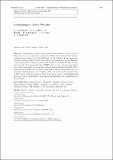| dc.contributor.author | Balogh, A. | |
| dc.contributor.author | Gombosi, T. I. | |
| dc.contributor.author | Baker, D. N. | |
| dc.contributor.author | Huba, J. D. | |
| dc.contributor.author | Lanzerotti, L. J. | |
| dc.contributor.author | Erickson, Philip J | |
| dc.date.accessioned | 2018-06-14T17:28:54Z | |
| dc.date.available | 2018-06-14T17:28:54Z | |
| dc.date.issued | 2017-04 | |
| dc.identifier.issn | 0038-6308 | |
| dc.identifier.issn | 1572-9672 | |
| dc.identifier.uri | http://hdl.handle.net/1721.1/116317 | |
| dc.description.abstract | Anthropogenic effects on the space environment started in the late 19th century and reached their peak in the 1960s when high-altitude nuclear explosions were carried out by the USA and the Soviet Union. These explosions created artificial radiation belts near Earth that resulted in major damages to several satellites. Another, unexpected impact of the high-altitude nuclear tests was the electromagnetic pulse (EMP) that can have devastating effects over a large geographic area (as large as the continental United States). Other anthropogenic impacts on the space environment include chemical release experiments, high-frequency wave heating of the ionosphere and the interaction of VLF waves with the radiation belts. This paper reviews the fundamental physical process behind these phenomena and discusses the observations of their impacts. Keywords: High-altitude nuclear explosions, Artificial radiation belts, Electromagnetic pulse (EMP), Damage to satellites, Space Debris, Chemical releases, HF heating, VLF waves and radiation belts | en_US |
| dc.description.sponsorship | National Science Foundation (U.S.) (Grant AGS-1242204) | en_US |
| dc.publisher | Springer Netherlands | en_US |
| dc.relation.isversionof | http://dx.doi.org/10.1007/s11214-017-0357-5 | en_US |
| dc.rights | Article is made available in accordance with the publisher's policy and may be subject to US copyright law. Please refer to the publisher's site for terms of use. | en_US |
| dc.source | Springer Netherlands | en_US |
| dc.title | Anthropogenic Space Weather | en_US |
| dc.type | Article | en_US |
| dc.identifier.citation | Gombosi, T. I., et al. “Anthropogenic Space Weather.” Space Science Reviews, vol. 212, no. 3–4, Nov. 2017, pp. 985–1039. | en_US |
| dc.contributor.department | Haystack Observatory | en_US |
| dc.contributor.mitauthor | Erickson, Philip J | |
| dc.relation.journal | Space Science Reviews | en_US |
| dc.eprint.version | Author's final manuscript | en_US |
| dc.type.uri | http://purl.org/eprint/type/JournalArticle | en_US |
| eprint.status | http://purl.org/eprint/status/PeerReviewed | en_US |
| dc.date.updated | 2018-02-22T05:06:02Z | |
| dc.language.rfc3066 | en | |
| dc.rights.holder | Springer Science+Business Media Dordrecht | |
| dspace.orderedauthors | Gombosi, T. I.; Baker, D. N.; Balogh, A.; Erickson, P. J.; Huba, J. D.; Lanzerotti, L. J. | en_US |
| dspace.embargo.terms | N | en |
| dc.identifier.orcid | https://orcid.org/0000-0002-0031-9324 | |
| mit.license | PUBLISHER_POLICY | en_US |
